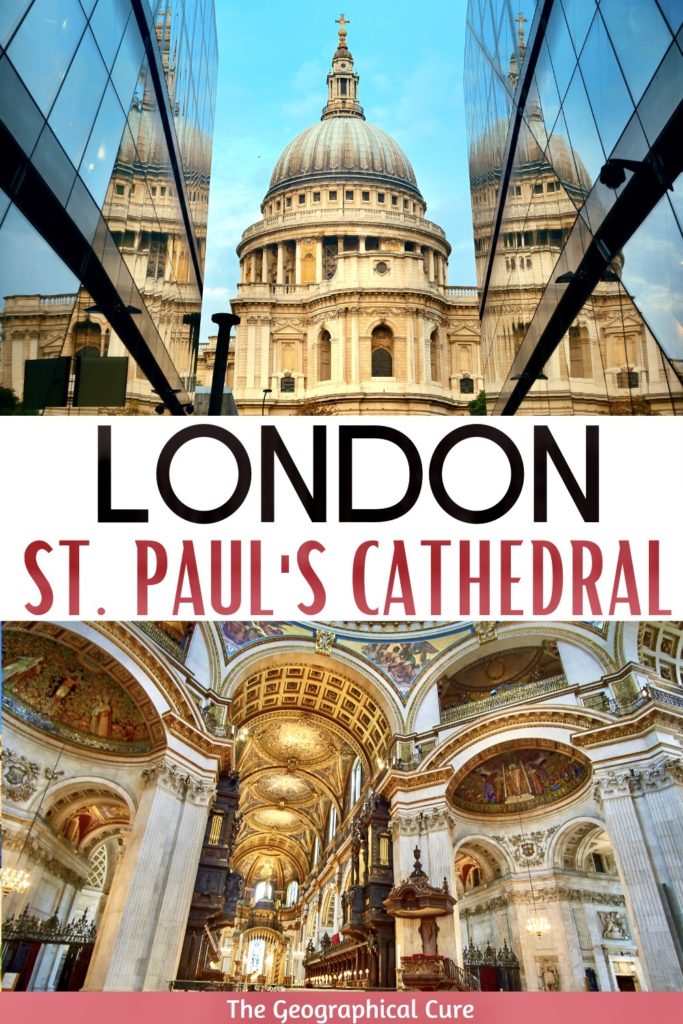St. Paul’s Cathedral is an iconic landmark in London that’s likely on your London bucket list. It’s the largest and most famous of London’s many churches. It’s the seat of the Bishop of London and parish church of the British Commonwealth.
In this St. Paul’s guide, I give you an overview of the cathedral and tell you what to see inside. I also give you tips for visiting and climbing the magnificent dome, which is a must do.
Here’s a snapshot of what you can see on a visit:
- facade
- nave
- monuments
- quire
- chapels
- cupola frescos
- mosaics
- baldachin
- crypt & tombs
- dome climb
- Harry Potter staircase
- library
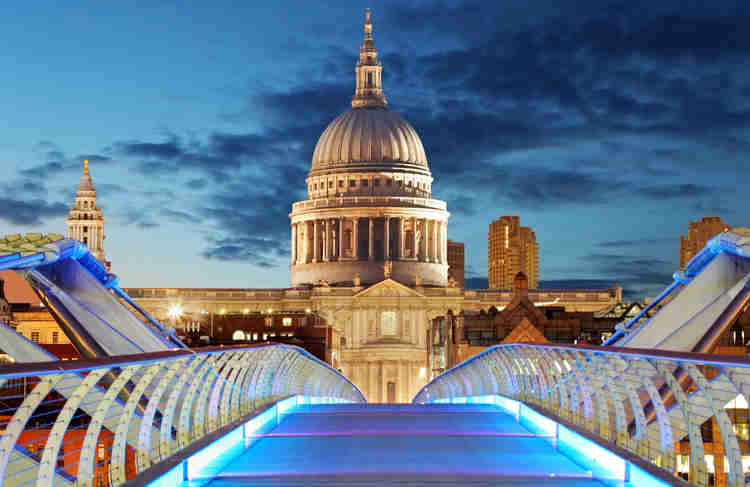
Tickets & Tours For St. Paul’s Cathedral
Click here to purchase a ticket to visit St. Paul’s Cathedral. You also have free skip the line entry to the cathedral if you purchased the London Pass.
You may want to book a guided tour of the cathedral because there is so much to see inside — mosaics, funerary tombs, sculptures, and artworks.
You can book a 2.5 hour guided tour of St. Paul’s and other London viewpoints. You can also book a 3 hour private tour of St. Paul’s.
You can customize this private tour and may see some of St. Paul’s secret spots (like the triforium and spiral staircase) that aren’t on a standard tour.
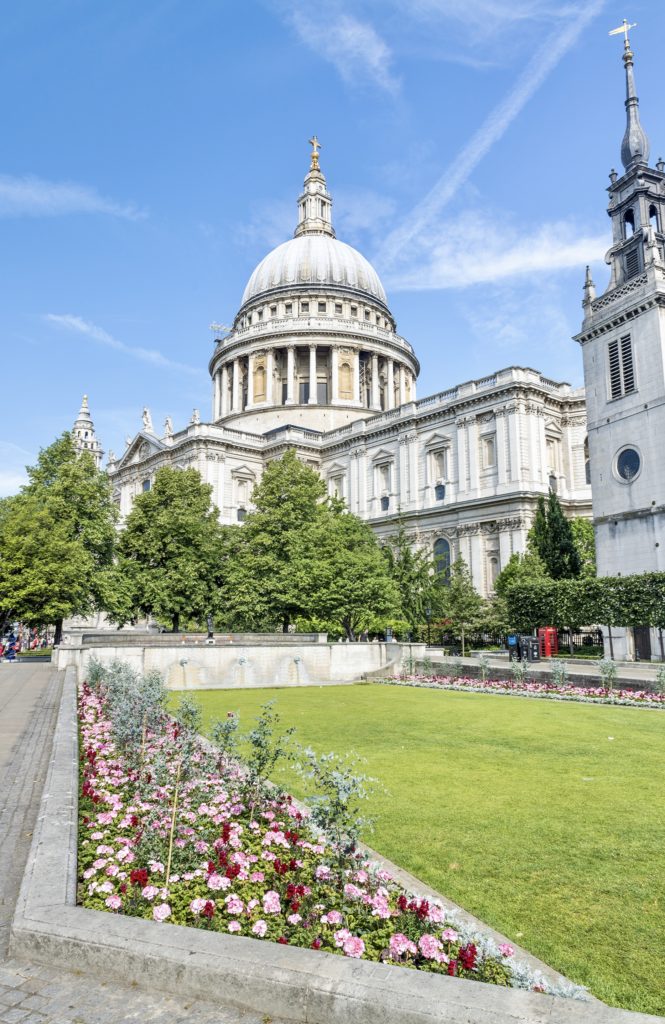
A Short History of St. Paul’s Cathedral
A cathedral dedicated to St. Paul has stood on Ludgate Hill for 1,400 years. The first church was built around 604 A.D.
A guide may tell you that it was built on a Roman temple. But that tale has been debunked.
The cathedral has a colorful history. It’s been looted, burned, and destroyed.
The St. Paul’s Cathedral you see today is actually the fifth to be built on this site. It was designed by Sir Christopher Wren, England’s foremost architect.
Wren planned a mosaicked and colorful cathedral interior. But this idea found an unreceptive audience and was deemed too “Rome-ish.”
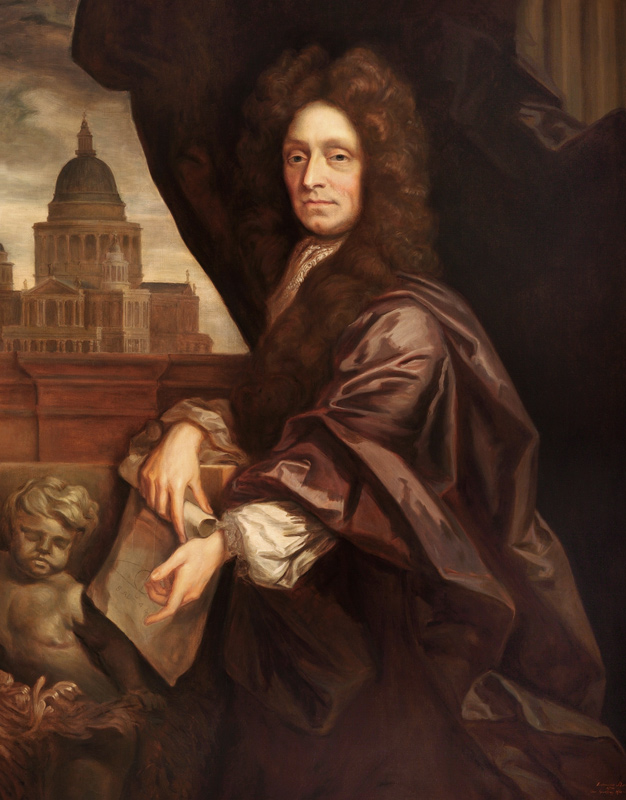
The Anglican clergy wanted to distance St. Paul’s from the over-the-top Baroque decoration of St. Peter’s Basilica in Rome. The result was an austere cathedral without colorful decoration.
To try to brighten up the place, the Victorians later added glittering mosaics around the apse, choir, and inside the dome.
St. Paul’s miraculously survived the Blitz during WWII, with only minor damage.
The dome stood courageously in the fire and smoke from the incendiary bombs. It became a symbol of Nazi resistance and renewal.
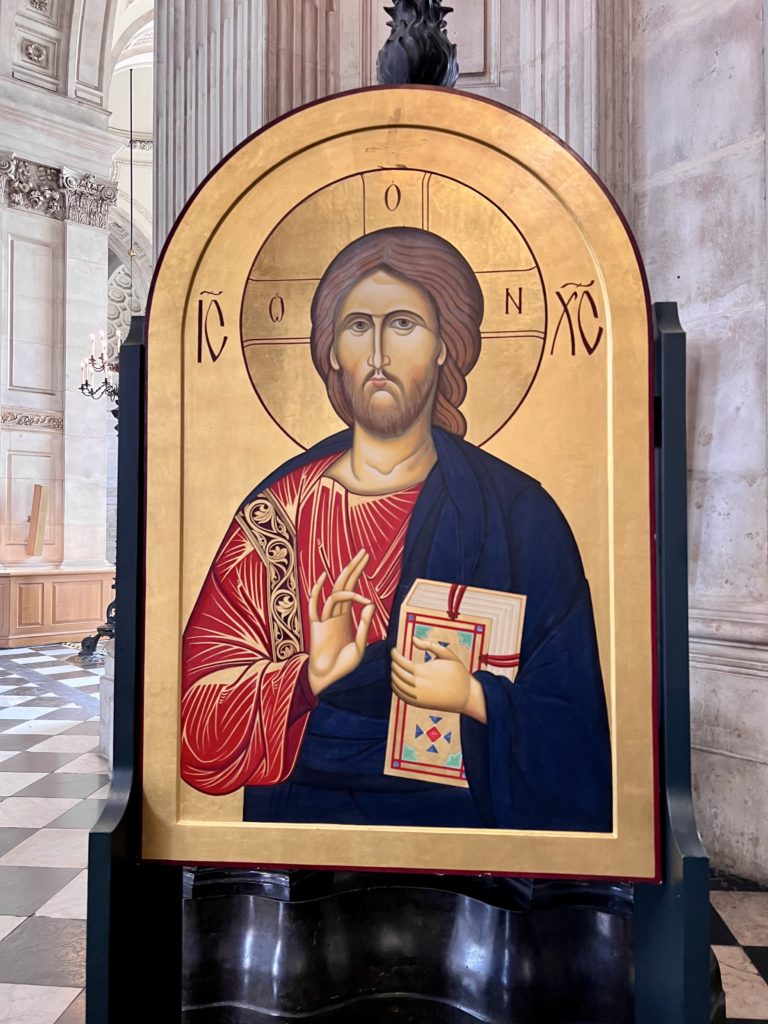
The dark Victorian glass was blown out and beautiful stained glass replaced it. The pink marble Victorian high altar was also smashed to bits.
It was replaced with the current baldachin, which was originally designed by Wren.
If you head to the west end of the nave, you can see a large white diamond shaped floor tile. It’s a memorial to the volunteers of the St. Paul’s Watch, the team responsible for defending the cathedral from attack.
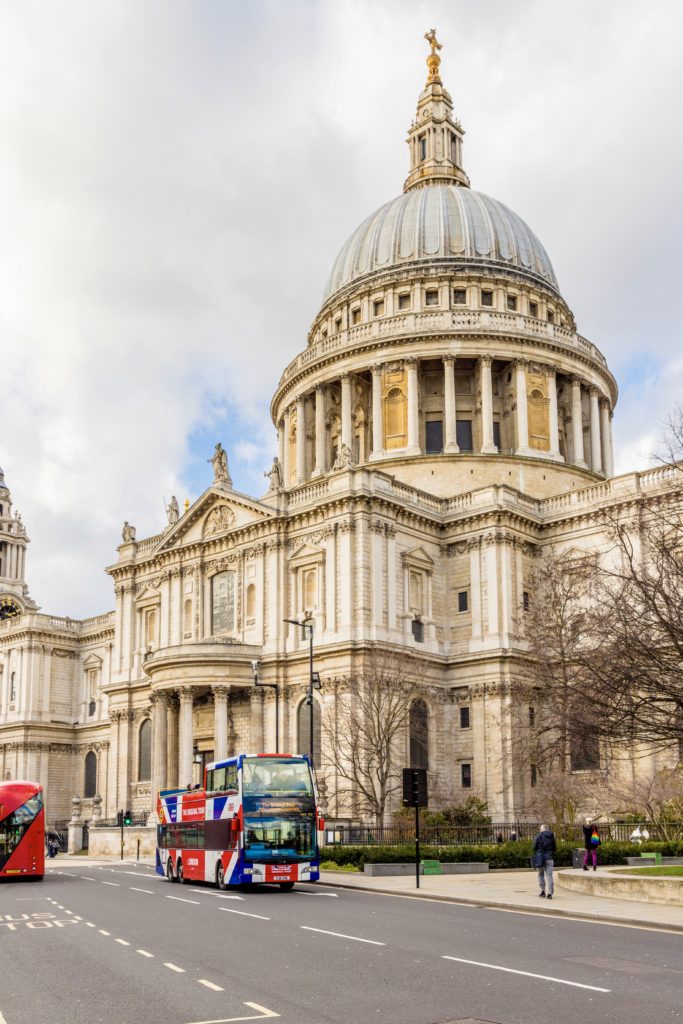
St. Paul’s has been the site of royal funerals and weddings and events of international importance.
The cathedral hosted the funerals for Lord Nelson, the Duke of Wellington, Sir Winston Churchill, and Margaret Thatcher.
Martin Luther King stopped here to preach on his way to pick up his Nobel Prize. This was where Princess Diana and Prince Charles were married.
The cathedral hosted the Thanksgiving services for the Silver, Golden, and Diamond Jubilees and the 80th and 90th birthdays of Queen Elizabeth II.
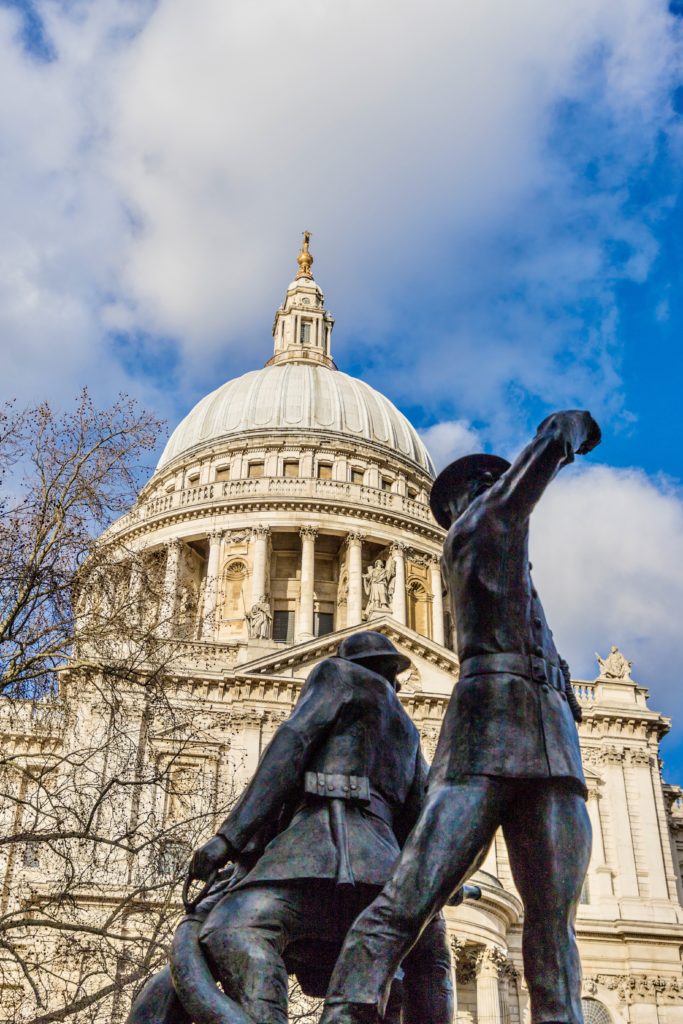
Guide To St. Paul’s Cathedral: What To See
Here are the highlights and best things to see at St. Paul’s Cathedral.
1. Exterior Facade
The cathedral has the scale and classicism of St. Peters Basilica in Rome. It’s a church of spectacular dimensions: 515 feet long and 227 feet wide across the transepts.
There are two 212 foot high towers on the west facade and a magnificent 365 foot dome.
The west front is dominated by a triangular pediment. It depicts Saint Paul’s conversion to Christianity.
Various statues surround the cathedral. You’ll see a statue of Queen Anne, a statute of Saint Paul, and The Fearless Girl sculpture.
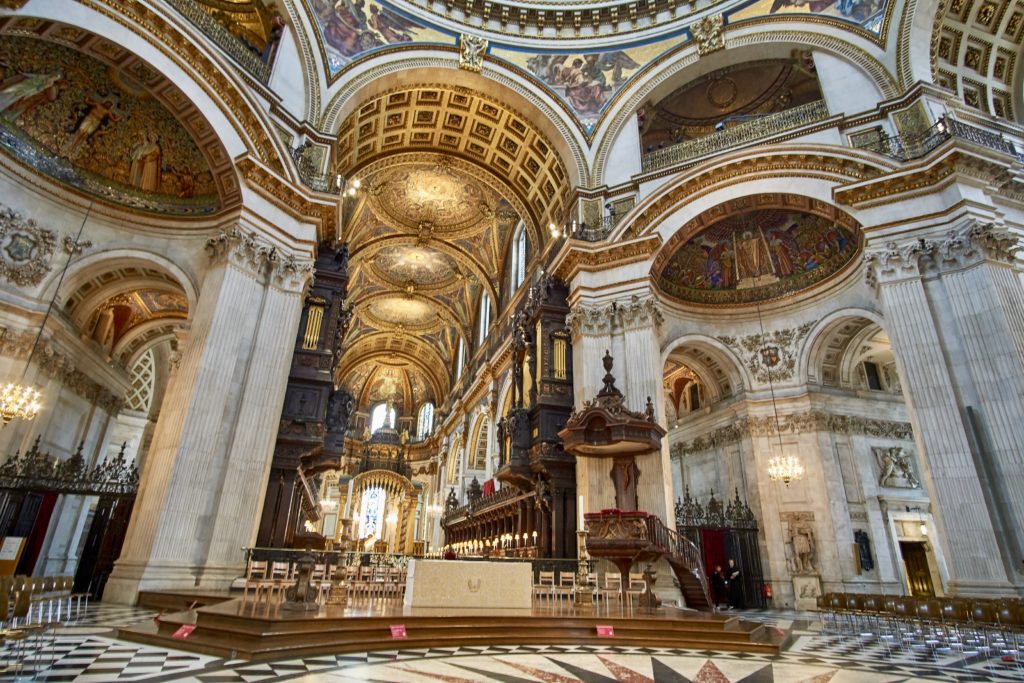
2. Nave
Heading inside, the first thing you see is the grand nave. Wren keep the medieval concept of a nave with side aisles. But rather than use cross vaults, he substituted saucer dome vaults.
The west end of the nave is dominated by the great West Doors. This is the ceremonial entrance used for VIPs. The white marble font used for baptisms is placed in front of that door.
The nave is a space of a dual nature. Part of it has the classic architectural ornamentation designed by Wren. But the character changes from the dome up to the apse.
Two centuries after Wren’s building was completed, it was decided that the cathedral needed some brightening up. So, colorful mosaics were added in the Victoria era giving the cathedral a more ornate feel.
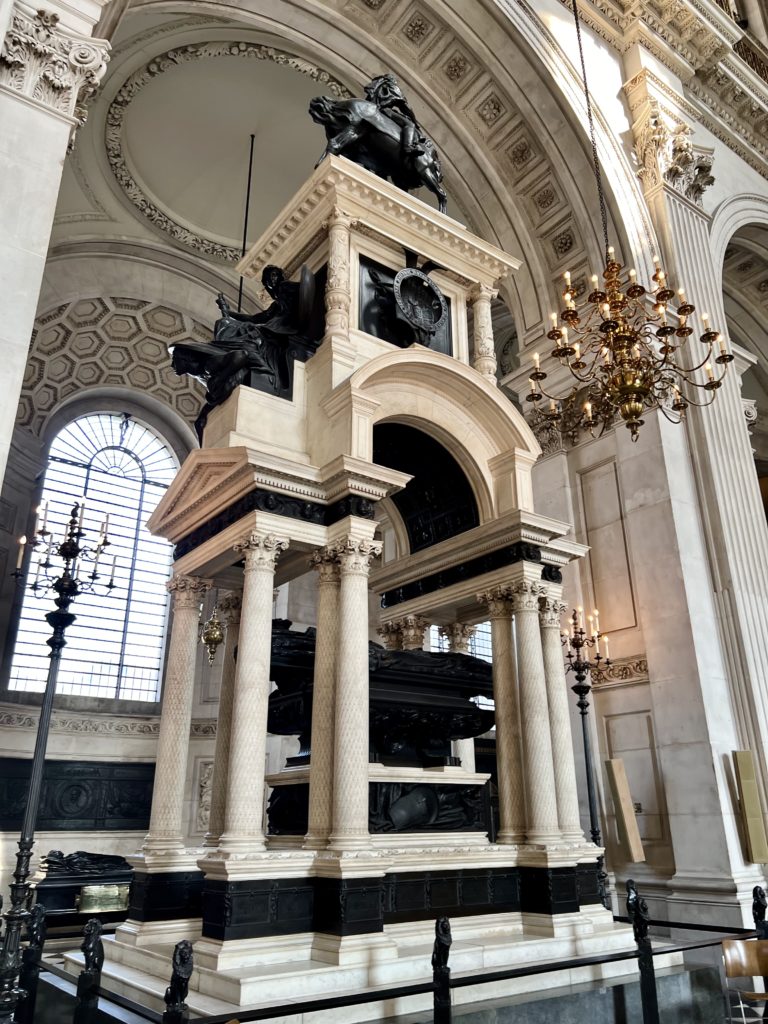
3. Nave Monuments
The nave is scattered with many monuments and sculptures.
The most spectacular monument is the Duke of Wellington memorial in the central bay. Wellington was best known for defeating Napoleon at Waterloo in 1815.
The monument was created in 1818 by Neo-Classical sculptor John Flaxman. It’s considered one of the most important sculptures from the 19th century.
The arched sculpture recalls a classical Roman triumphal arch. Beneath it is a recumbent bronze effigy of the duke.
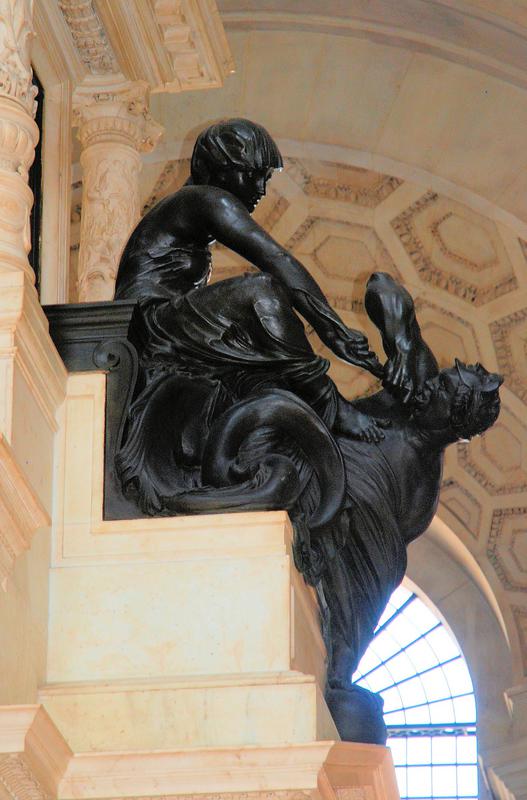
Above it is an equestrian statue. The statue sits on a plinth decorated with a group of allegorical figures known as Valour and Cowardice and Truth and Falsehood. They are strongly influenced by Michelangelo.
I also liked the Henry Moore statue, Mother and Child. Moore was one of Britain’s foremost sculptors, practically inventing the genre of modern sculpture.
He received the commission for the statue in 1983 and even chose the location for his work.
Close to Moore’s sculpture are two pairs of beautiful wrought iron gates. They were made by Jean Bijou around 1700.
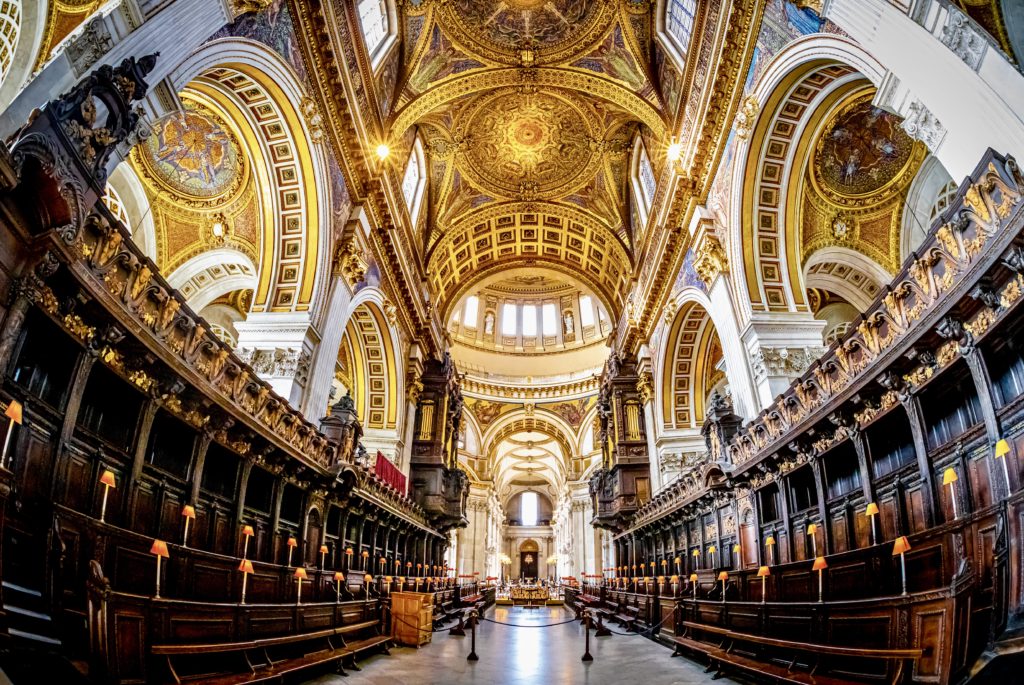
4. Quire
The quire was the first part of the cathedral to be built and is its most sacred space. Originally, it was walled off with an elaborate rood screen. But that was removed in the 1860s.
Both sides of the quire have exquisitely carved wooden stalls with canopies. They were created by the Dutch sculptor Grinling Gibbons.
The quire bays and aisles have hundreds of mosaics. They depicts narrative scenes from the Old Testament.
The quire is still used for its original purpose. It’s where the choir, clergy, and people sit for Evensong, a service that thanks god for the day.
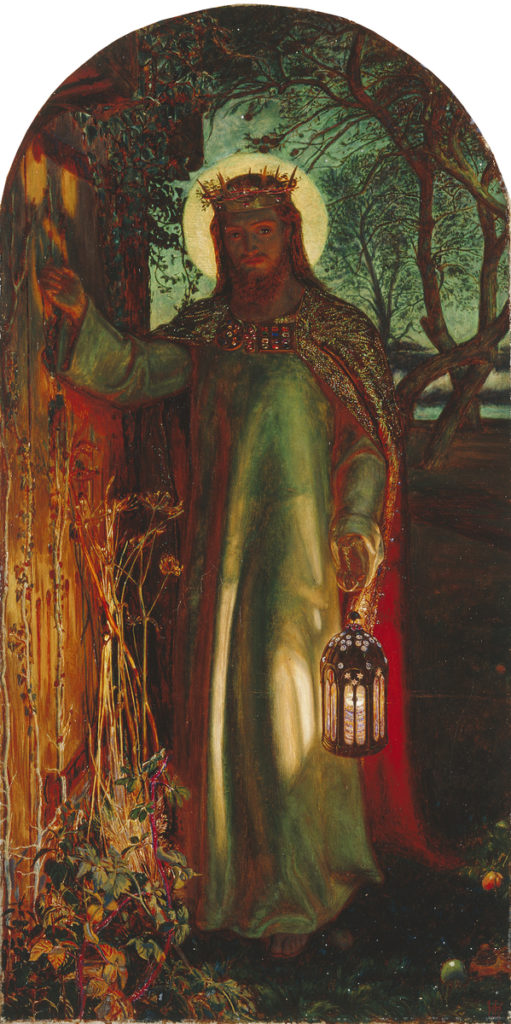
5. Chapels
St. Paul’s is also home to a number of interesting chapels, most of them accessible from the nave.
St. Dunstan’s Chapel was consecrated in 1699. It was dedicated to St. Dunstan, an Archbishop of Canterbury.
The chapel is important because the sacrament hangs above the altar. You can light a candle here. There are also beautiful mosaics on the west and east walls.
The Chapel of St. Michael and St. George is filled with banners. The banners are for the current knight and officers of the Order.
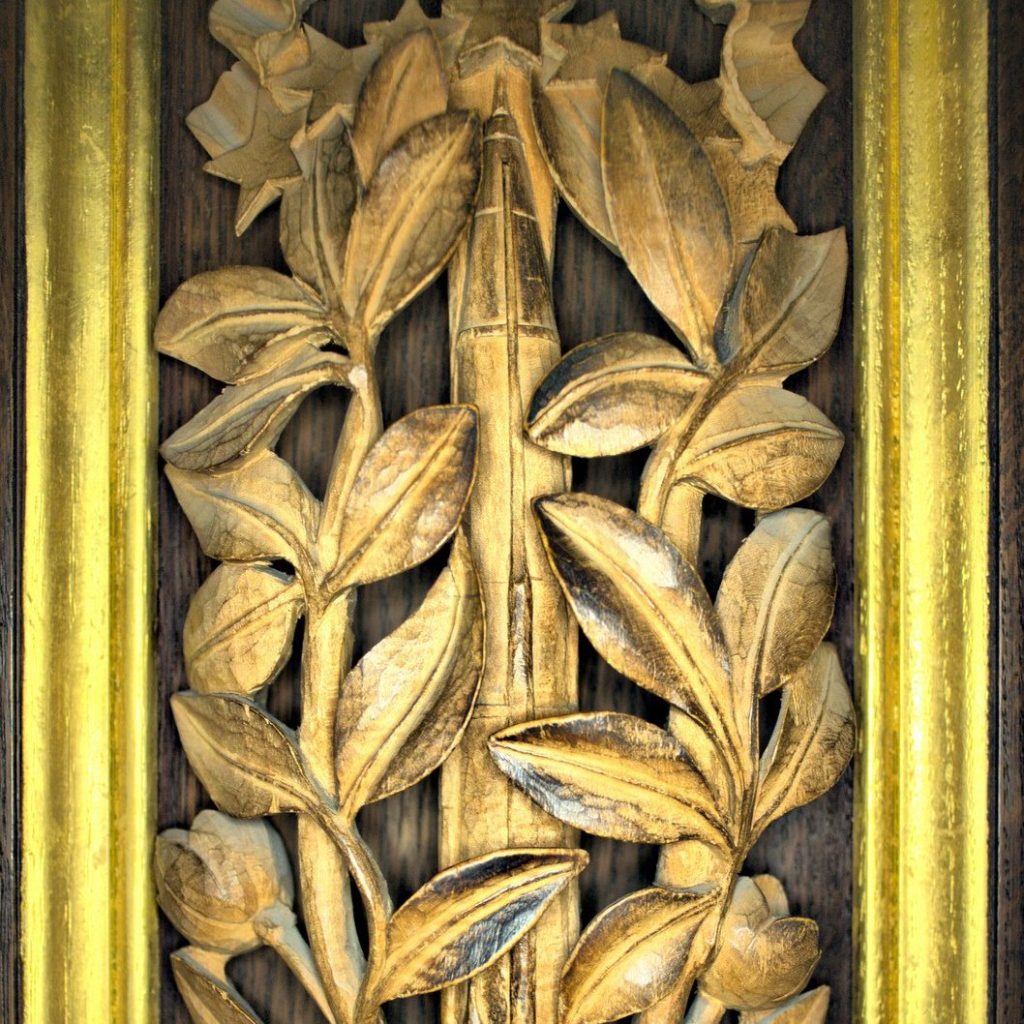
The Chapel of Saints Erkenwald and Ethelburga has a beautiful altarpiece painted by the Pre-Raphaelite artist William Holden Hunt called the Light of the World.
It depicts Christ in a dark wood, holding a lantern and knocking at an overgrown door with no handle. The painting traveled the world in 1905 and achieved cult status.
READ: Pre-Raphaelite Paintings In London
Consecrated in 1958, the American Memorial Chapel is behind the high altar at the east end of the cathedral. The chapel commemorates Americans who were stationed in Britain during WWII.
At the heart of the chapel is a leather bound book, an honor role to the 28,000 Americans who served and gave their lives. The stained glass windows contain the symbols of all states.
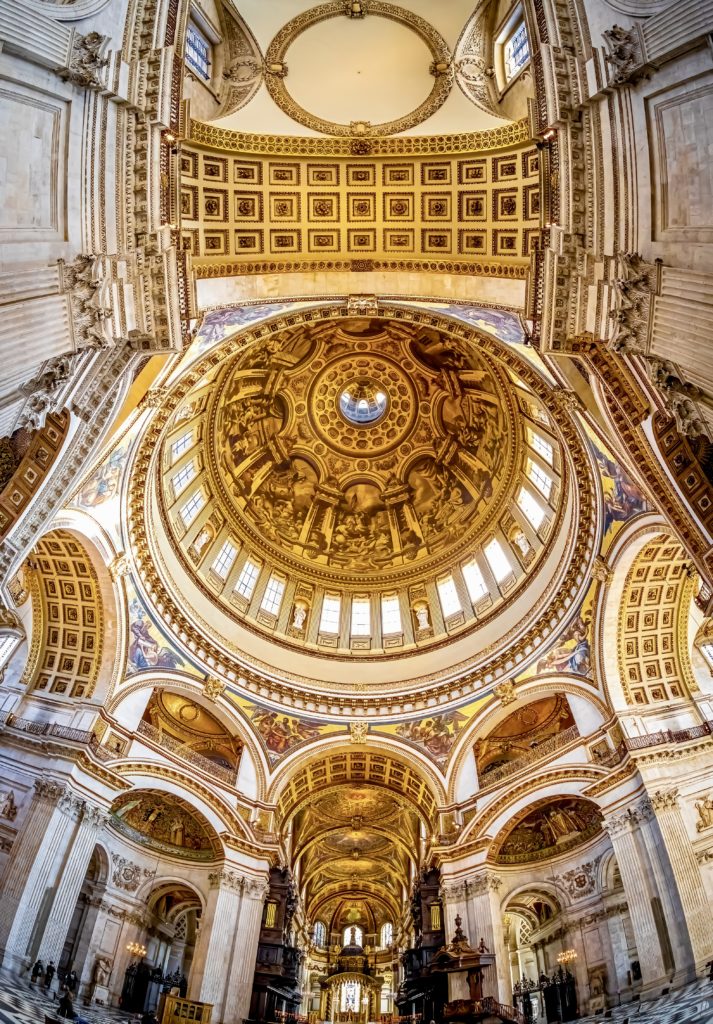
6. Cupola Frescos
The cupola of the dome was painted by James Thornhill. The guards will encourage you to lay down on the sundial beneath it to get the best photo.
In June 1715, Thornhill was officially awarded the much-coveted commission to decorate the dome, for which he had been competing since 1709.
Thornhill worked on the dome from 1715-19. The frescos depict eight scenes from the life of St. Paul.
The terms of the commission required Thornhill to use a muted palette of stone like browns. Wren reputedly hated the gloomy murals. He had wanted mosaics in the dome. But that proved to be too expensive and showy.
Unfortunately, the Thornhill originals deteriorated over time. So the monochromatic designs were repainted in 1853-56 and again restored in 2003-05.
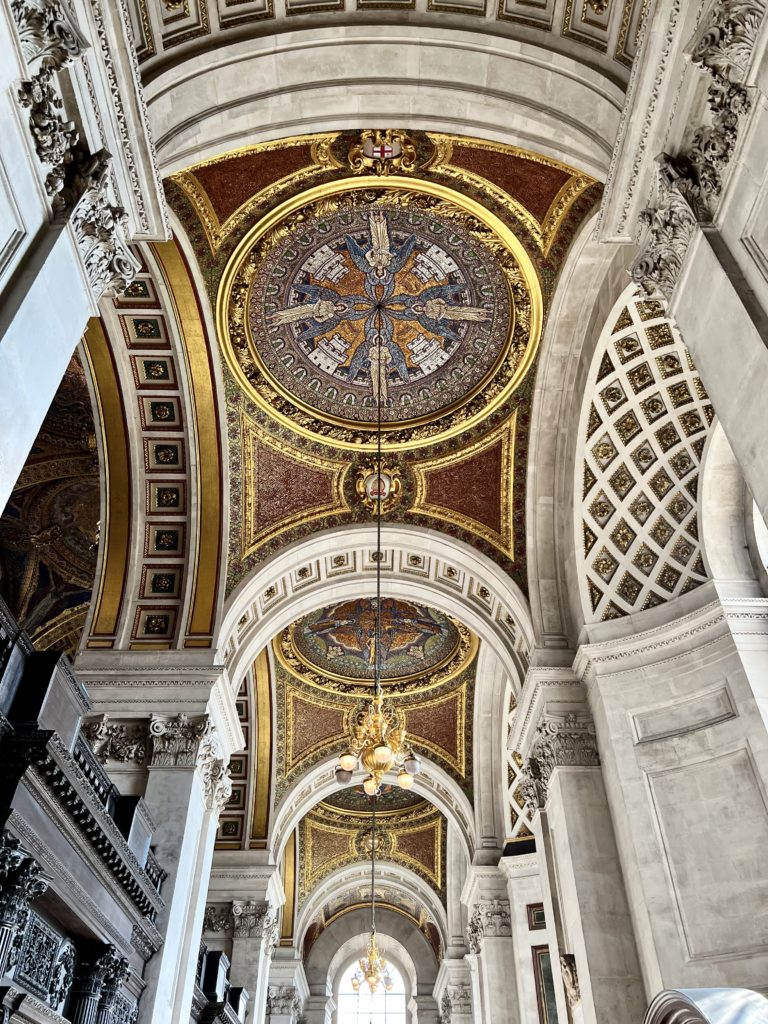
7. Mosaics
Queen Victoria famously though St. Paul’s was “dull and dingy.” In response to that remark, over 6 million mosaics were installed in 1896-1904.
The ceiling mosaics illustrate the story of creation from the Old Testament, with Adam and Eve being tempted and expelled from paradise.
The wall mosaics tell the story of the annunciation, when the angel Gabriel tells Mary she will give birth to Jesus.
The mosaics have a twin inspiration — ancient Byzantine mosaics from Ravenna Italy and designs from the British Arts and Crafts era.
READ: Guide To the Mosaics of Ravenna
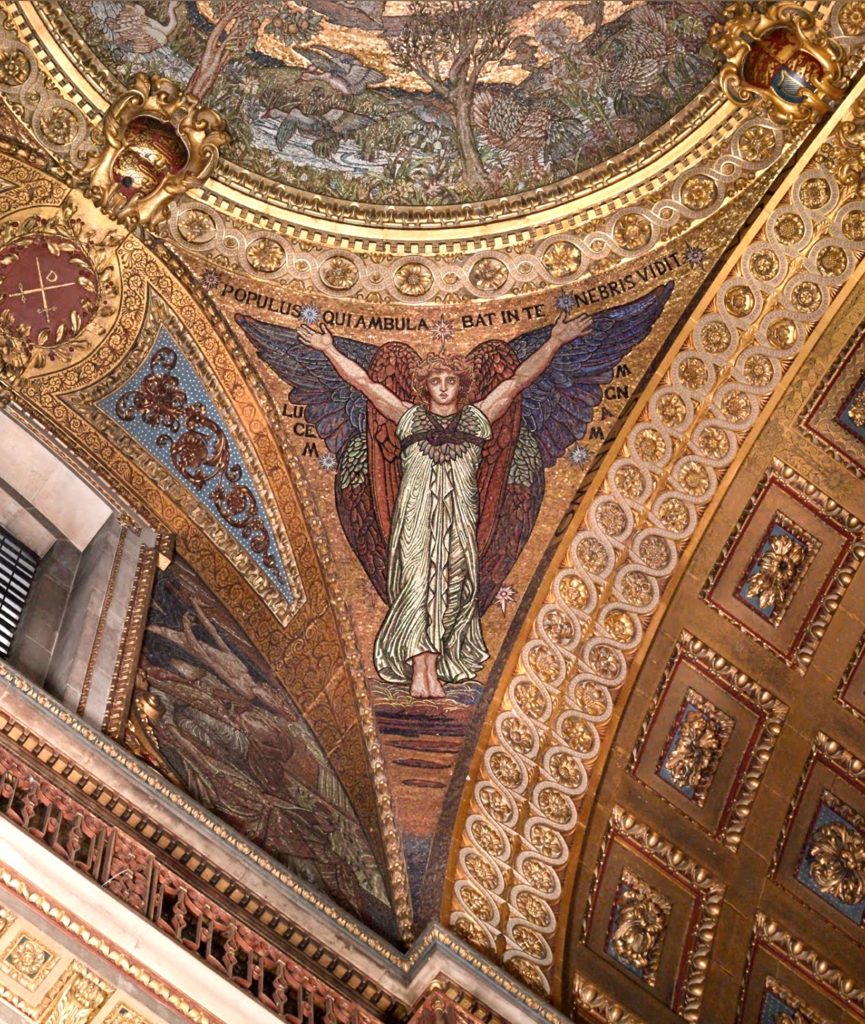
The mosaic designs were created by the painter William Black Richmond, a pupil of John Ruskin.
The artist Edward Burne-Jones had turned down the job, not wanting to mess with Wren’s creation. Richmond, on the other hand, saw it as the opportunity of a lifetime.
His plan was ambitious. The ceilings of the quire, its walls and aisles were to be encrusted with millions of tesserae made of colored glass and gold leaf.
Richmond also designed stained glass windows to accompany his mosaic work, but these designs were lost in WWII.
The mosaics are dazzling and vividly colored. A risen Christ in judgment presides over all, high in the apse above the high altar.
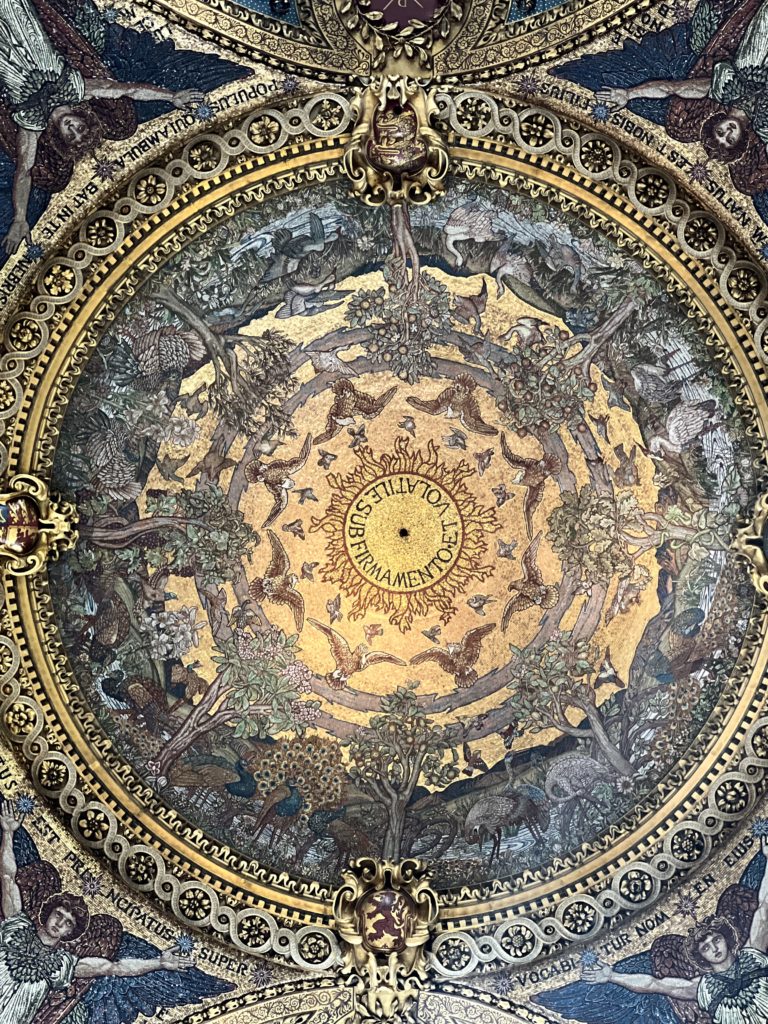
Taking his inspiration from the Book of Revelation, Richmond depicts Christ triumphant, his arms raised in blessing. He is flanked by recording angels who have lists of the actions and prayers of each individual.
Richmond was most proud of The Creation of the Fishes in the central saucer dome. He used the mosaics to masterful effect creating a turbulent, frothing sea populated with lithe and fearsome fishes.
Eight mosaics were also added under the main dome. The V-shaped spandrel mosaics depict prophets and evangelists against a gold background.
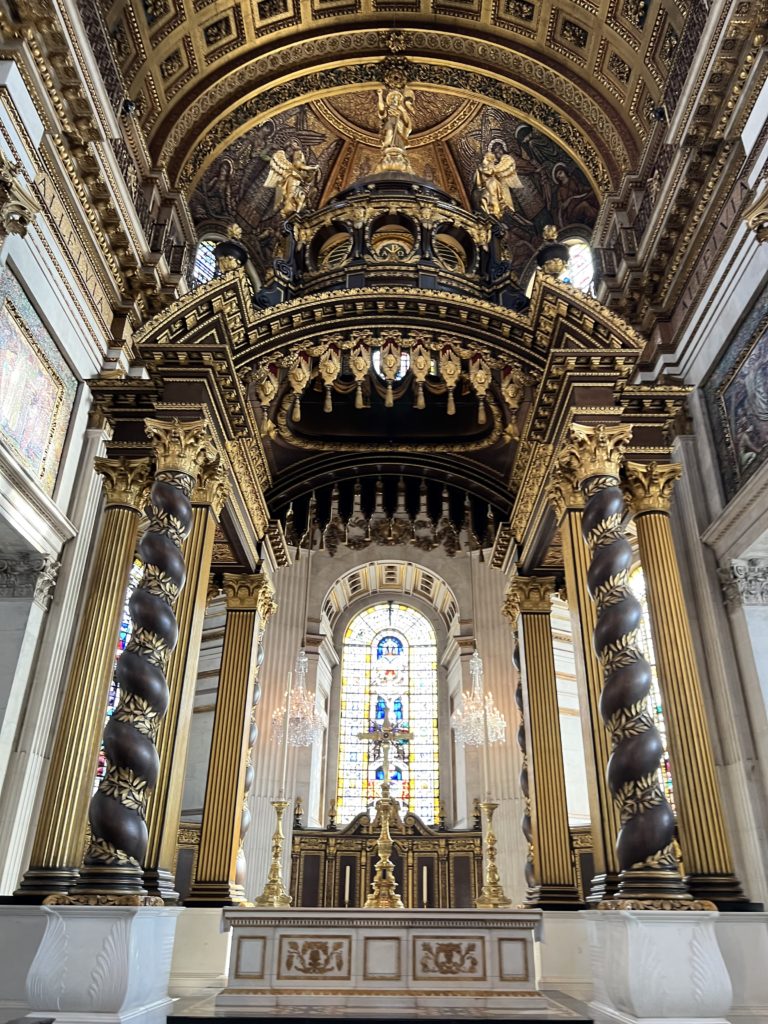
8. Baldachin
The cathedral’s baldachin, or high altar, was added in 1958. It was designed to reflect Wren’s original intent. There’s a gilded statue of Jesus on the top.
To me, it resembles the baldachin designed by Gian Lorenzo Bernini in St. Peter’s Basilica in Rome.
9. Crypt
The crypt is the cathedral’s burial chamber. It’s largest of its kind in Europe. Three death heads mark the entrance.
The crypt is the final resting place of a number of famous Brits, including Admiral Horatio Nelson, the Duke of Wellington, and Sir Christopher Wren himself.
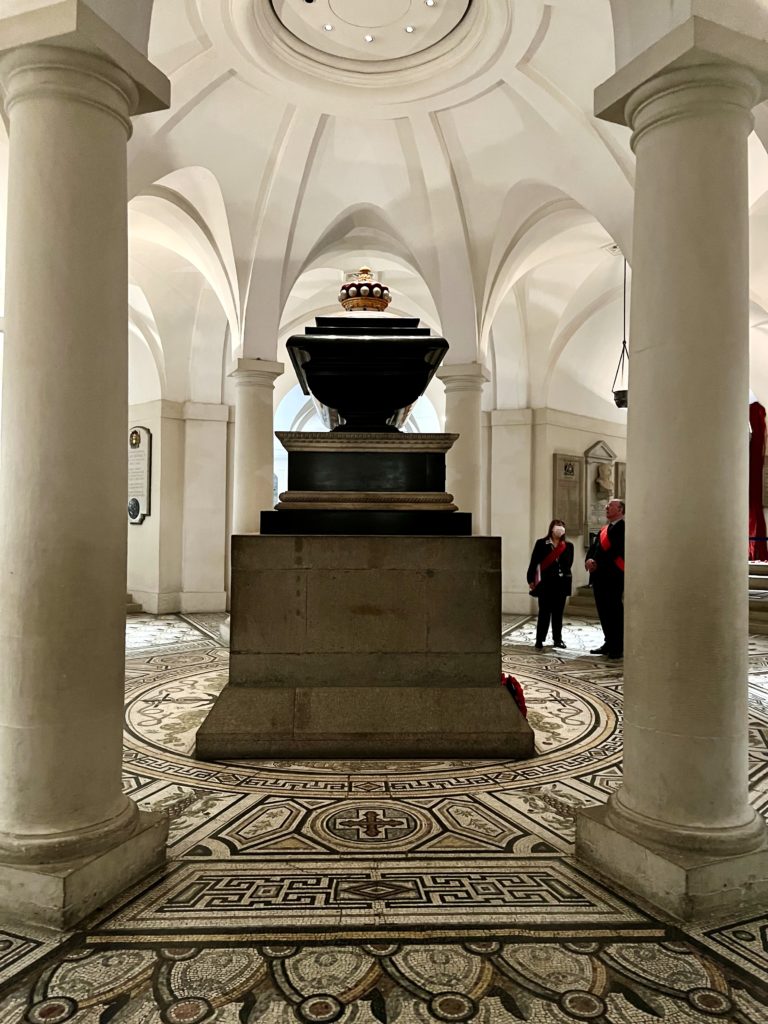
Nelson’s black marble sarcophagus is one of the oldest things inside the cathedral.
It was made in the 1520s for Cardinal Wolsey, Henry VIII’s Lord Chancellor. When Henry and Wolsey fell out over Henry’s divorce plans, the sarcophagus was never used.
The wooden coffin inside the sarcophagus was made from the timber of the French flagship, L’Orient, which Nelson defeated in battle.
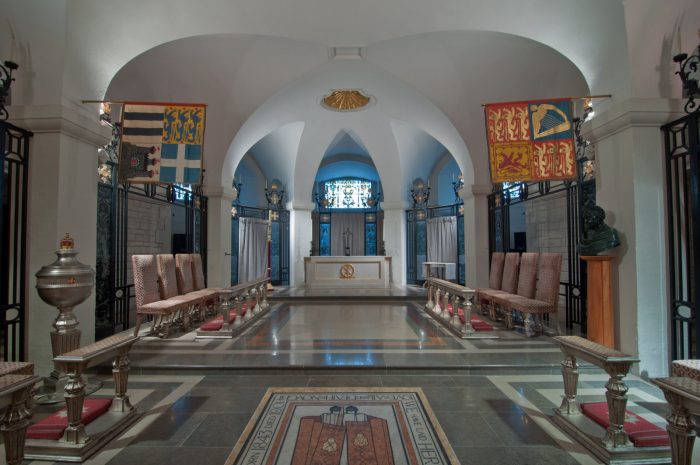
Wren is buried in the south aisle of the crypt’s Chapel of St. Faith. Fittingly, the tomb inscribed with the words “if you seek his monument, look around you.”
Lord Wellington is buried in a simple but imposing granite casket. It’s surrounded by banners that were used in his funeral procession.
Surrounding the chapel are memorials to figures from the arts and sciences, including the famous British painters Joshua Reynolds, John Everett Millais, William Blake, and J.M.W. Tuner.
READ: Guide To the Tate Britain Museum
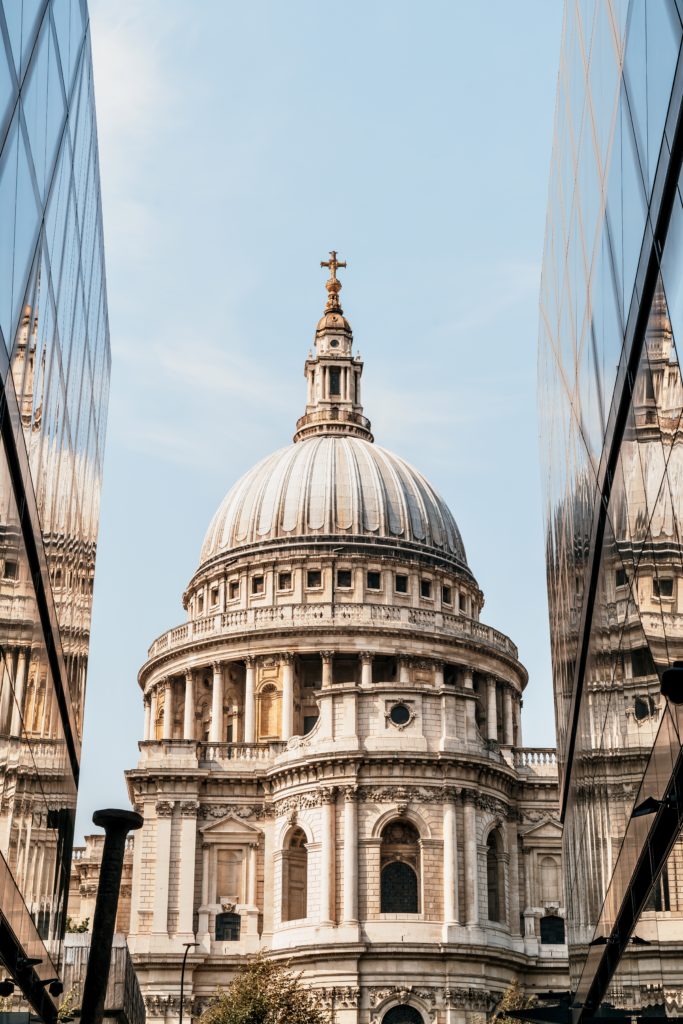
10. Dome
St. Paul’s renowned dome crowns the intersection of its arms. It’s one of the largest cathedral domes in the world, weighing in at 65,000 tons. It may have been inspired by Bramante’s Tempietto in Rome.
St. Paul’s dome is actually several domes. It has a three dome structure: the exterior dome, a middle dome, and the inner dome.
The middle dome has an unseen brick core that supports the stone lantern. An iron belt prevents the dome from bulging outward.
The best place to see and get a shot of the dome is from the One New Change shopping center. Head to the 6th floor for a free view.
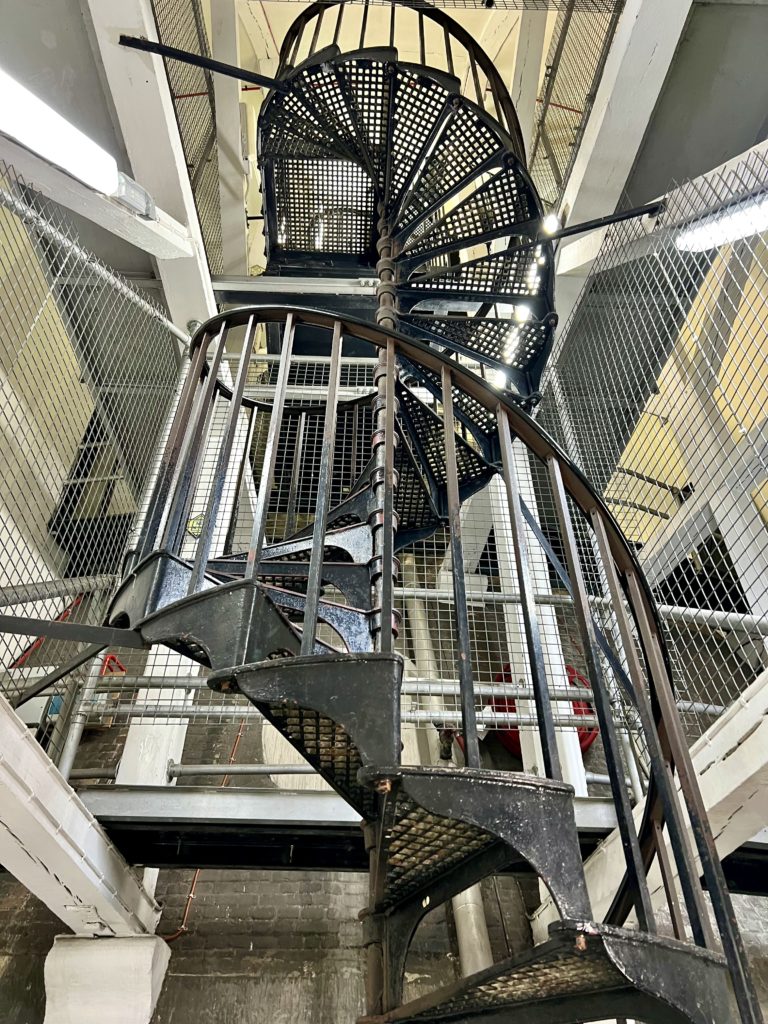
11. Dome Climb
The cathedral admission includes access to climb to the top of the dome. The entrance is to your right after you enter the cathedral.
I highly recommend this, if you’re able to ascend the 528 steps.
But be forewarned, it’s a steep spiral climb and a hard slog. The stairway is dimly lit and not for the faint of heart. You may have to mind your head. In some parts, there are no hand rails.

12. Dome Galleries
Within the dome’s structure, there are three galleries — the famous Whispering Gallery, the Stone Gallery, and the Golden Gallery.
You reach the Whispering Gallery by climbing 259 steps. From here, visitors can see Thornhill’s paintings up close and gain a breathtaking impression of the size and proportions of the nave below.
The Whispering Gallery has unique acoustics. Sounds travels around the circular hall. So a whisper on one side can be heard on the other side.
To test it out, enter the gallery with a travel partner, stand on opposite sides, and face the wall. If you whisper facing the wall, the sound of your voice will travel around the curved edge and reach your friend.
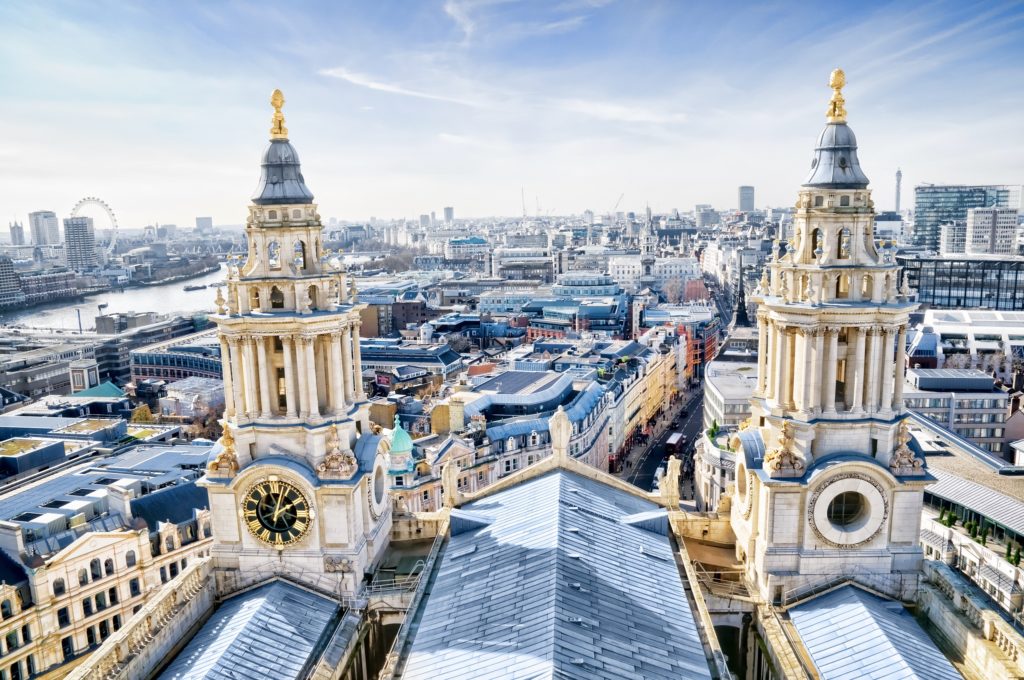
Unfortunately, the Whispering Gallery was closed when I visited, so I didn’t get to try this experiment.
Two higher galleries encircle the outside of the dome. It’s another 119 steps up is the Stone Gallery. From there, there are great views, as it’s an outside area around the dome.
The Golden Gallery is the third gallery. It encircles the highest point of the outer dome and is the smallest gallery.
You can inspect the iconic dome at closer range.The views from the gallery are spectacular and take in many London landmarks including the River Thames, Tate Modern, and the Globe Theater.
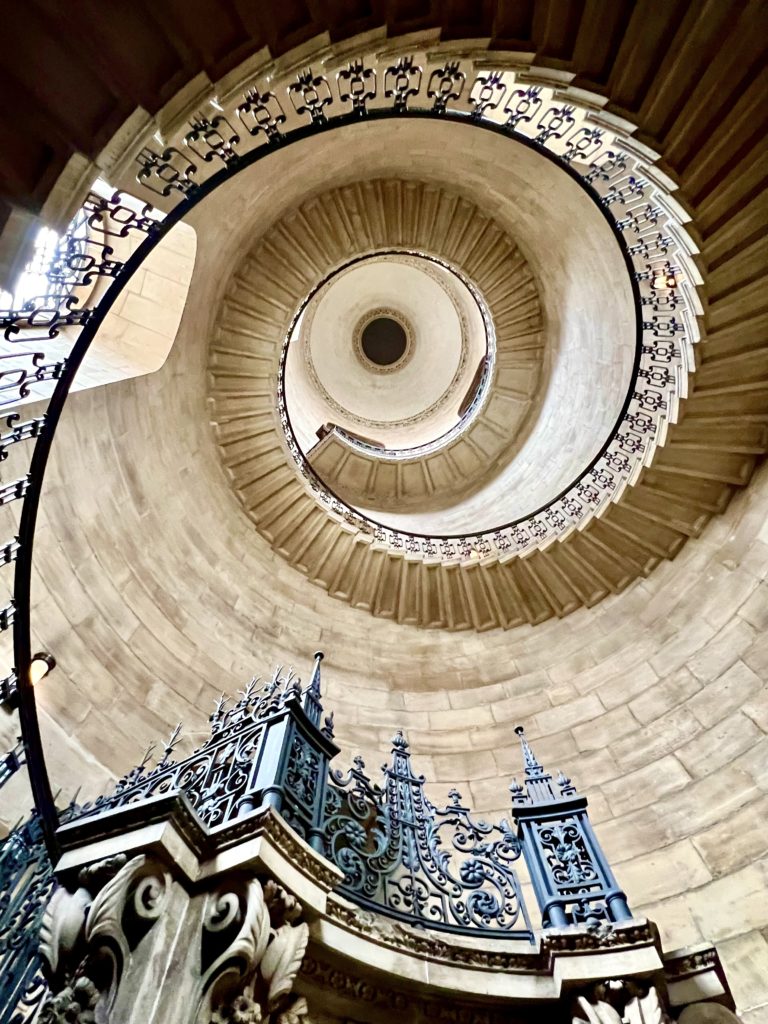
13. Secret Spiral Staircase
There’s also a secret spiral staircase in the southwest bell tower. The staircase was used in the film Harry Potter and the Prisoner of Azkaban. It was the Divination Staircase used to gain access to Professor Trelawney’s Divination classroom.
In real life, the staircase is known as the Dean’s Stairs. It was designed by Christopher Wren in 1705 and built by William Kempster.
You can’t access the staircase on a standard visit to St. Paul’s. It’s under lock and key.
You will only see it on a guided Harry Potter tour, a private tour, or a Triforium tour. If you’re on a private tour, your guide can ask for the key at the guide desk. The key to unlock the staircase is massive and clunky, something you’d expect to see in the Harry Potter movies.
At the top of the staircase, you’ll have a beautiful view of the nave, sometimes dubbed the “BBC View.”
READ: Guide To Harry Potter Places in London
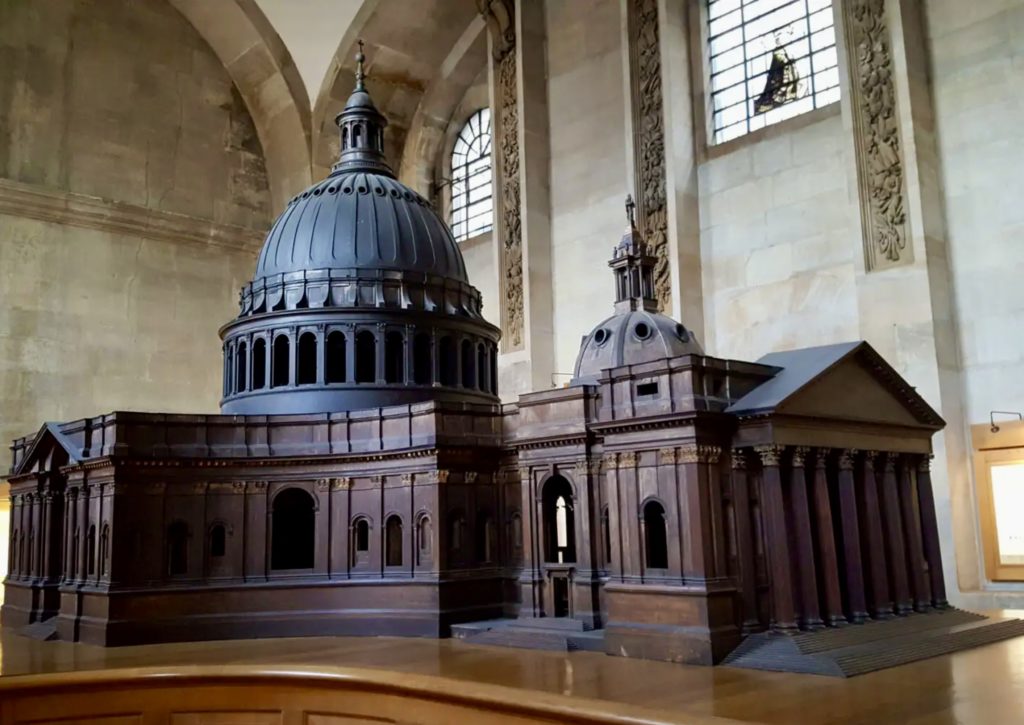
14. Triforium
Like every major cathedral, St. Paul’s has a “Triforium.” It’s a gallery above the arches of the nave within the thickness of an inner wall. Triforiums are usually closed off to the public.
St. Paul’s Triforium is only open on a very limited basis, so check the website to book tickets.
Public tours are £10 and leave at 12:30 pm. To get to the Triforium, you climb the Dean’s Staircase I mentioned above.
Usually, triforiums are used to store extra artifacts. But St. Paul’s has a secret treasure inside the Triforium’s Trophy Room — the original model for St. Paul’s created by Wren.
Wren struggled with the St. Paul’s design. He went through many iterations trying to please his patrons. Finally, Wren built a massive wooden model for King Charles II so he could see the architect’s vision.
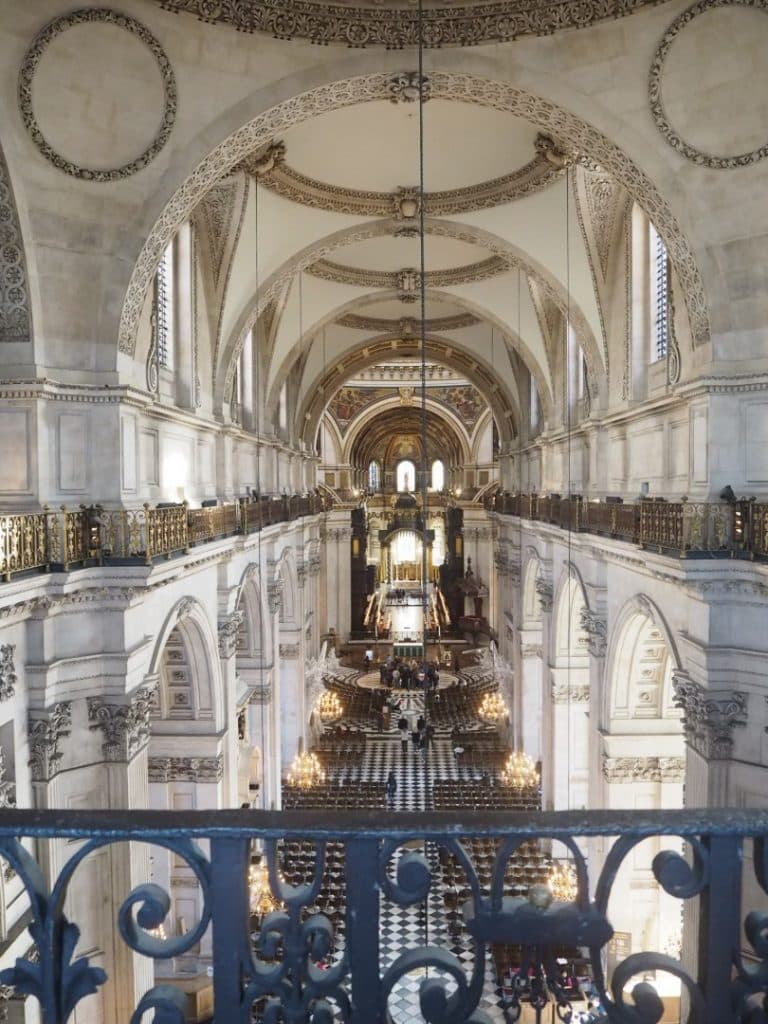
The king was convinced and construction began. But many design changes from the original were made during construction. Some historians say the original model was, architecturally speaking, Wren’s finest work.
15. Library
The Cathedral Library is a secret space in St. Paul’s. It has a gorgeous 18th century interior that was recently renovated.
The library is undergoing an extensive conservation to enhance environmental condition for the books and conserve the room. The library will re-open to the public in July 2022.
The library houses St. Paul’s superb collection of more than 21,000 books and manuscripts dating from 1690. When it’s reopened, you can see it if you book the Triforium tour.
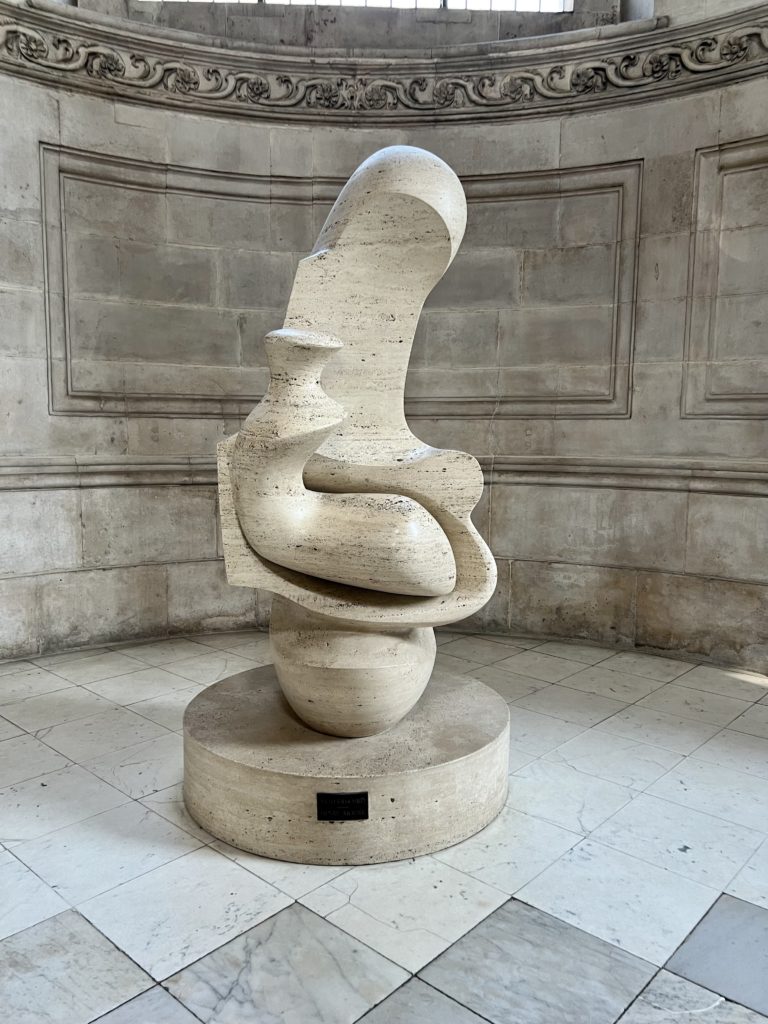
Practical Guide & Tips For St. Paul’s Cathedral
Address: St. Paul’s Churchyard, London EC4
Hours: The Cathedral is open to visitors every day from 8:30 am to 4:30 pm. However, on Sunday, the cathedral is open for worship only and there is no sightseeing. The dome galleries don’t open until 9:30 am.
Services: There are services Monday to Saturday at 7:30 am, 12:30 pm, and evensong at 5:00 pm.
Note: The Whispering Gallery is temporarily closed, with no estimate of when it will reopen.
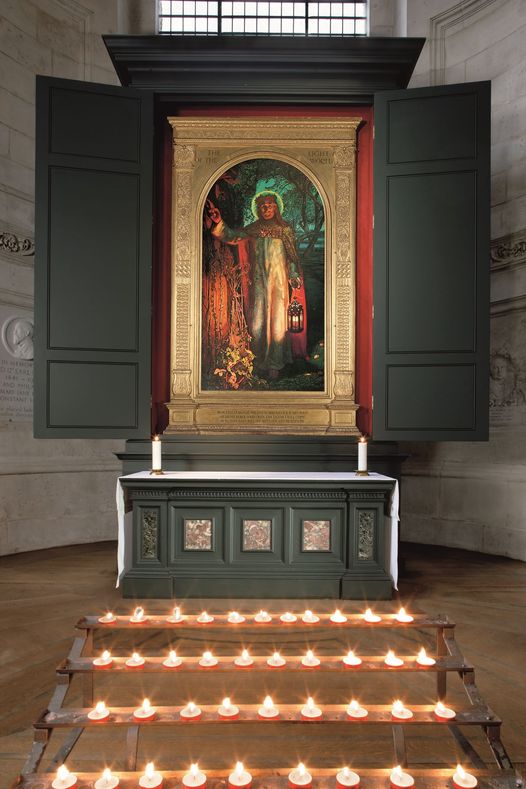
Ticket Price: £20.50 or free with the London Pass. The admission price includes use of excellent high resolution touch screen guides that feature film footage, images, interviews, and commentary relating to the cathedral.
Free Tours: Introductory talks about the architecture and history are given throughout the day. These free talks last from 15 to 20 minutes. Ask about the next one at the guide desk when you arrive.
Tube Stops: The nearest stops are St. Paul’s, Mansion House, and Blackfriars.
Museum Shop: If you need a souvenir or a guide book, there’s a large museum shop in the crypt. There are also restrooms and a cafe.
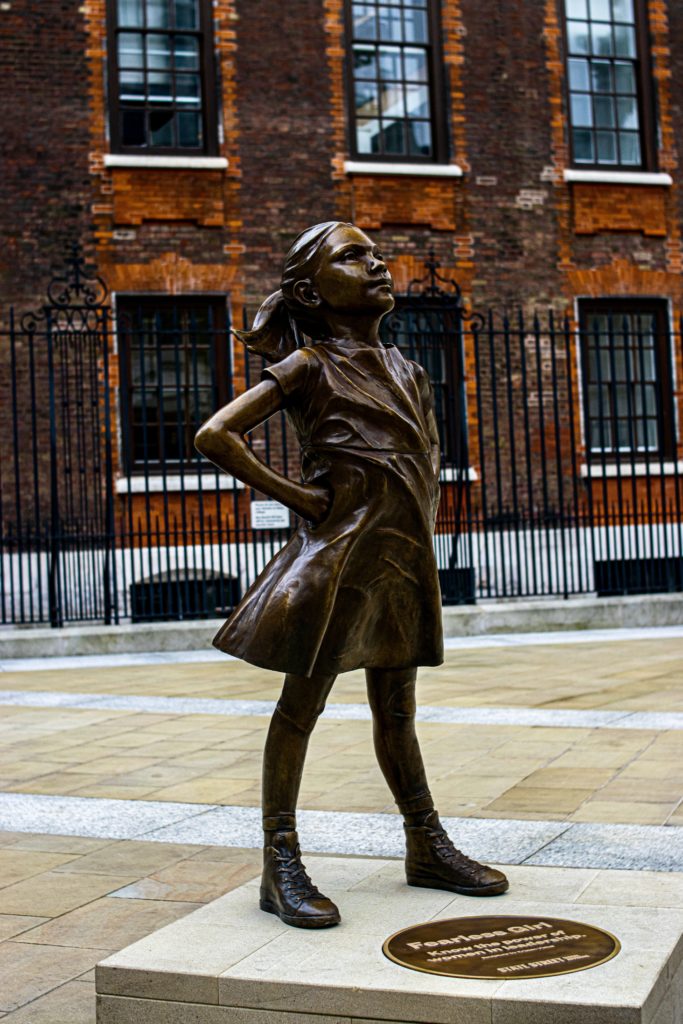
Where To Stay Near St. Paul’s Cathedral
Want to stay near the cathedral? It’s close to plenty of London’s other must visit attractions.
You can check out the Vintry & Mercer, a new luxury hotel with bespoke rooms. Cheval Calico House offers up luxury apartment suites.
And the Bankside Hotel Autograph Collection is an intimate six story hotel with a beautiful art collection.
Is St. Paul’s Cathedral Worth Visiting?
Yes the cathedral is definitely worth visiting and going inside. It’s one of London’s most iconic landmarks, a national treasure, and Wren’s defining masterpiece. The architecture, mosaics, and monuments are all stunning.
If the ticket price is too steep, try to attend a service to at least get a sense of the interior.
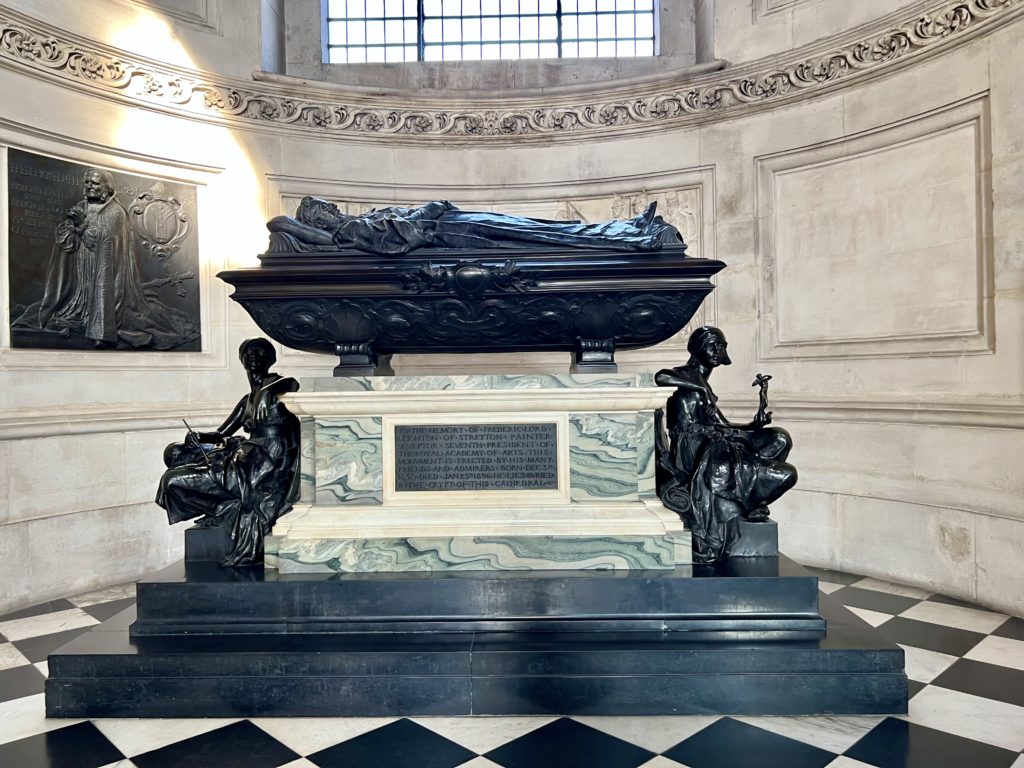
Pro Tips:
In the crypt, you can watch Oculus. It’s fascinating film experience that narrates the cathedral’s 1,400 years of history. The film allows you to virtually climb the many steps to the dome galleries, if you didn’t make it up there yourself.
Another way to see St. Paul’s is to visit the mall next to the cathedral, the One New Change shopping center. From the 6th floor, which you can access for free, you’ll have great close up views of the dome.
I hope you’ve enjoyed my guide to St. Paul’s Cathedral. You may enjoy these other England travel guides and resources:
- 5 Days in London Itinerary
- One Day In Bath Itinerary
- Guide To Free Museums in London
- Guide To the National Gallery of Art
- Harry Potter Places in London
- Guide To the Churchill War Rooms
- Guide To The Wallace Collection
- Tourist Traps To Avoid in London
- Guide To the Tower of London
- Guide To Hampton Court Palace
- Guide To Hatfield House
- Guide To The Henry VII Chapel
If you’d like to visit St. Paul’s Cathedral, pin it for later.

